Use the Printables navigation menu at the top to browse through the other categories of files.
total
Displaying 1 to 40 of 152 total files.
 ***Music Symbol PNG Files - for Making Worksheets***
***Music Symbol PNG Files - for Making Worksheets***
» 698.9 KiB - 91,502 hits - 16 April 2013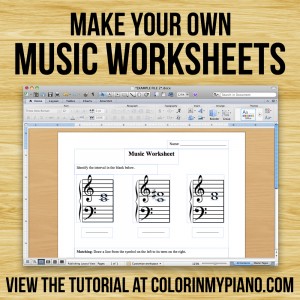 This zipped file contains a series of picture files of music symbols that you can insert into a Microsoft Publisher/Word document in order to create your own music worksheets.
This zipped file contains a series of picture files of music symbols that you can insert into a Microsoft Publisher/Word document in order to create your own music worksheets.
 12-Bar Blues in C
12-Bar Blues in C
» 642.8 KiB - 51,925 hits - 9 April 2013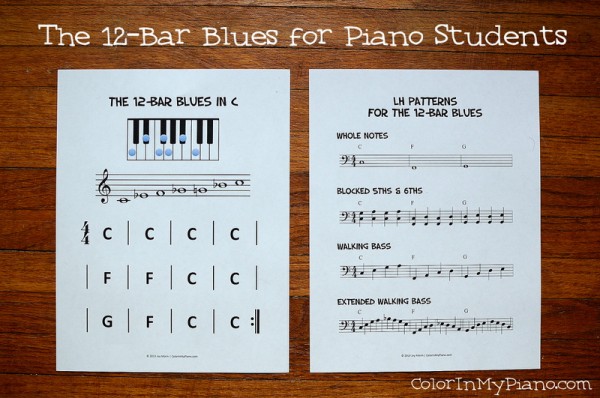 This printable breaks down this steps for teaching students improvise over the 12-bar blues progression in the key of C. On the top of page 1, the notes of the C blues scale are shown both on the keyboard and on the staff. Page 2 shows a variety of patterns that can be used to accompany an improvised melody. Finally, the bottom of page 1 shows the 12-bar blues progression. This printable can be used to help students improvise within the 12-bar blues by themselves, or as a duet with the teacher or another student. To view the original blog post about this printable, click here.
This printable breaks down this steps for teaching students improvise over the 12-bar blues progression in the key of C. On the top of page 1, the notes of the C blues scale are shown both on the keyboard and on the staff. Page 2 shows a variety of patterns that can be used to accompany an improvised melody. Finally, the bottom of page 1 shows the 12-bar blues progression. This printable can be used to help students improvise within the 12-bar blues by themselves, or as a duet with the teacher or another student. To view the original blog post about this printable, click here.
 15 FREE Printable Music Posters
15 FREE Printable Music Posters
» 8.6 MiB - 5,063 hits - 31 May 2021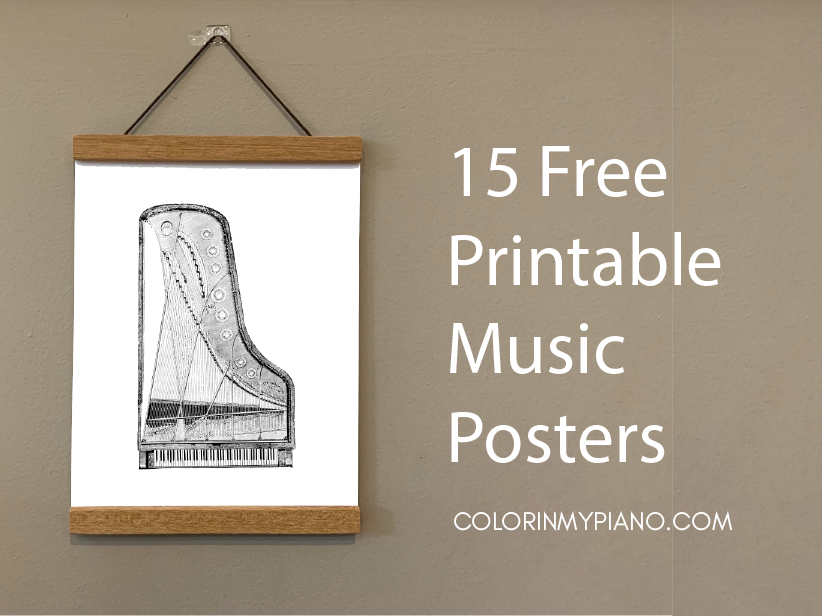 In this PDF, you’ll find a selection music-themed printable posters that are perfect as easy and beautiful artwork for YOUR music studio space. You'll find vintage piano advertisements, illustrations of inside the piano, and other music-themed artwork. You can use any regular picture frame, but I love the look of the 8-inch Magnetic Poster Frame Hanger pictured here so that's what I recommend. As a bonus, at the end of the PDF I’ve also included 4 nature-themed prints you might enjoy for a child’s play space or other area of your home. Read more here.
In this PDF, you’ll find a selection music-themed printable posters that are perfect as easy and beautiful artwork for YOUR music studio space. You'll find vintage piano advertisements, illustrations of inside the piano, and other music-themed artwork. You can use any regular picture frame, but I love the look of the 8-inch Magnetic Poster Frame Hanger pictured here so that's what I recommend. As a bonus, at the end of the PDF I’ve also included 4 nature-themed prints you might enjoy for a child’s play space or other area of your home. Read more here.
 1st Lesson: Interview with Beginner Student
1st Lesson: Interview with Beginner Student
» 47.1 KiB - 49,651 hits - 16 August 2011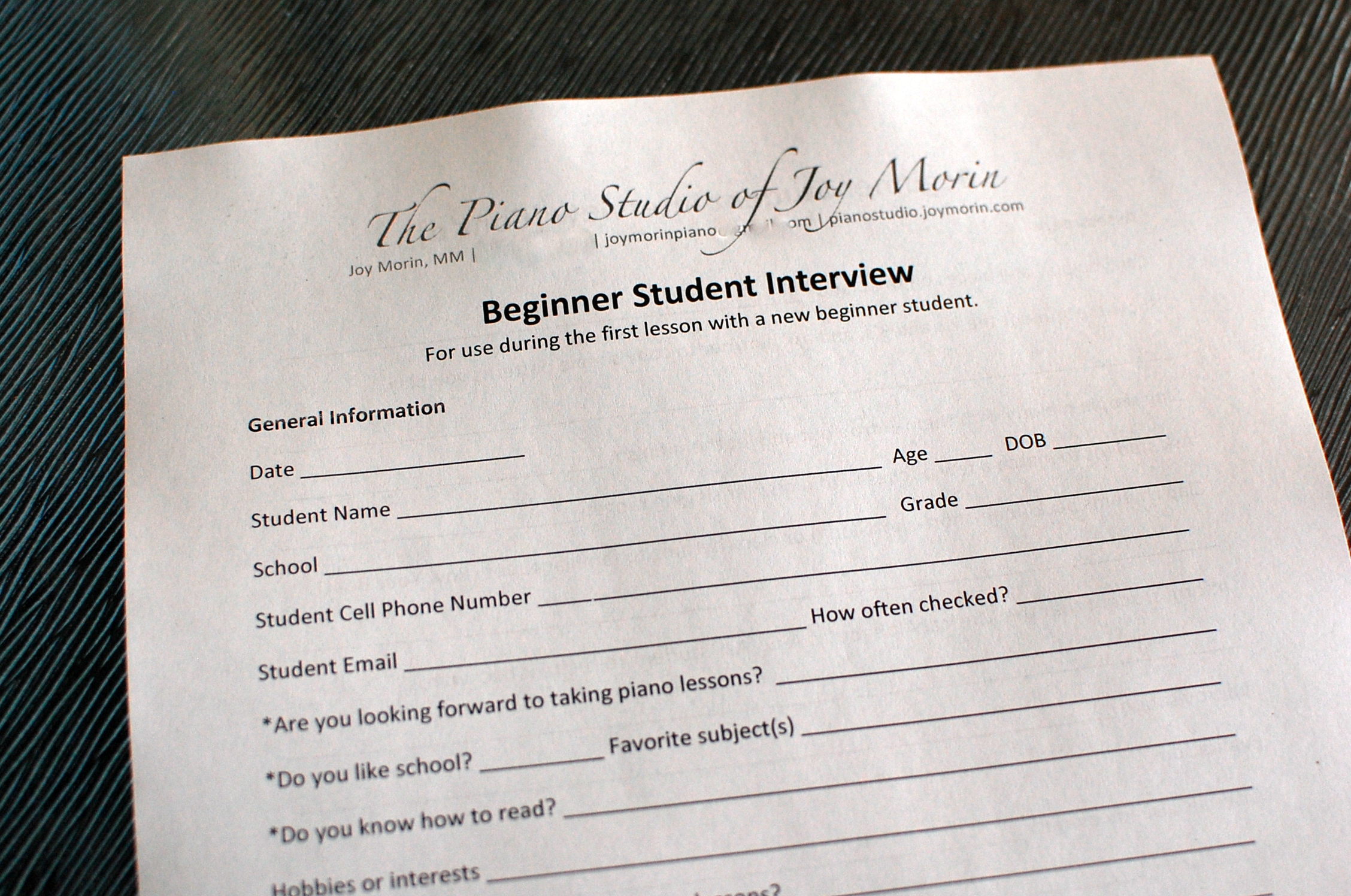 This form is designed for use during the first lesson with a new beginner-level student who you are accepting into your music studio. The first part of the form includes basic information for the student to provide verbally. The second part of the form lists activities for the teacher to conduct with the student, to help assess the student's musical aptitude/background.
This form is designed for use during the first lesson with a new beginner-level student who you are accepting into your music studio. The first part of the form includes basic information for the student to provide verbally. The second part of the form lists activities for the teacher to conduct with the student, to help assess the student's musical aptitude/background.
 1st Lesson: Interview with Transfer Student
1st Lesson: Interview with Transfer Student
» 45.6 KiB - 18,245 hits - 16 August 2011 This form is designed to be used during the first lesson with a new transfer student that you are considering for acceptance into your teaching studio. The first part of the form is basic information which the student can provide verbally. The second part of the form lists some activities which the teacher can conduct with the student in order to assess the student's previous training and musical background.
This form is designed to be used during the first lesson with a new transfer student that you are considering for acceptance into your teaching studio. The first part of the form is basic information which the student can provide verbally. The second part of the form lists some activities which the teacher can conduct with the student in order to assess the student's previous training and musical background.
 1st Lesson: Student Information Form
1st Lesson: Student Information Form
» 57.4 KiB - 31,456 hits - 16 August 2011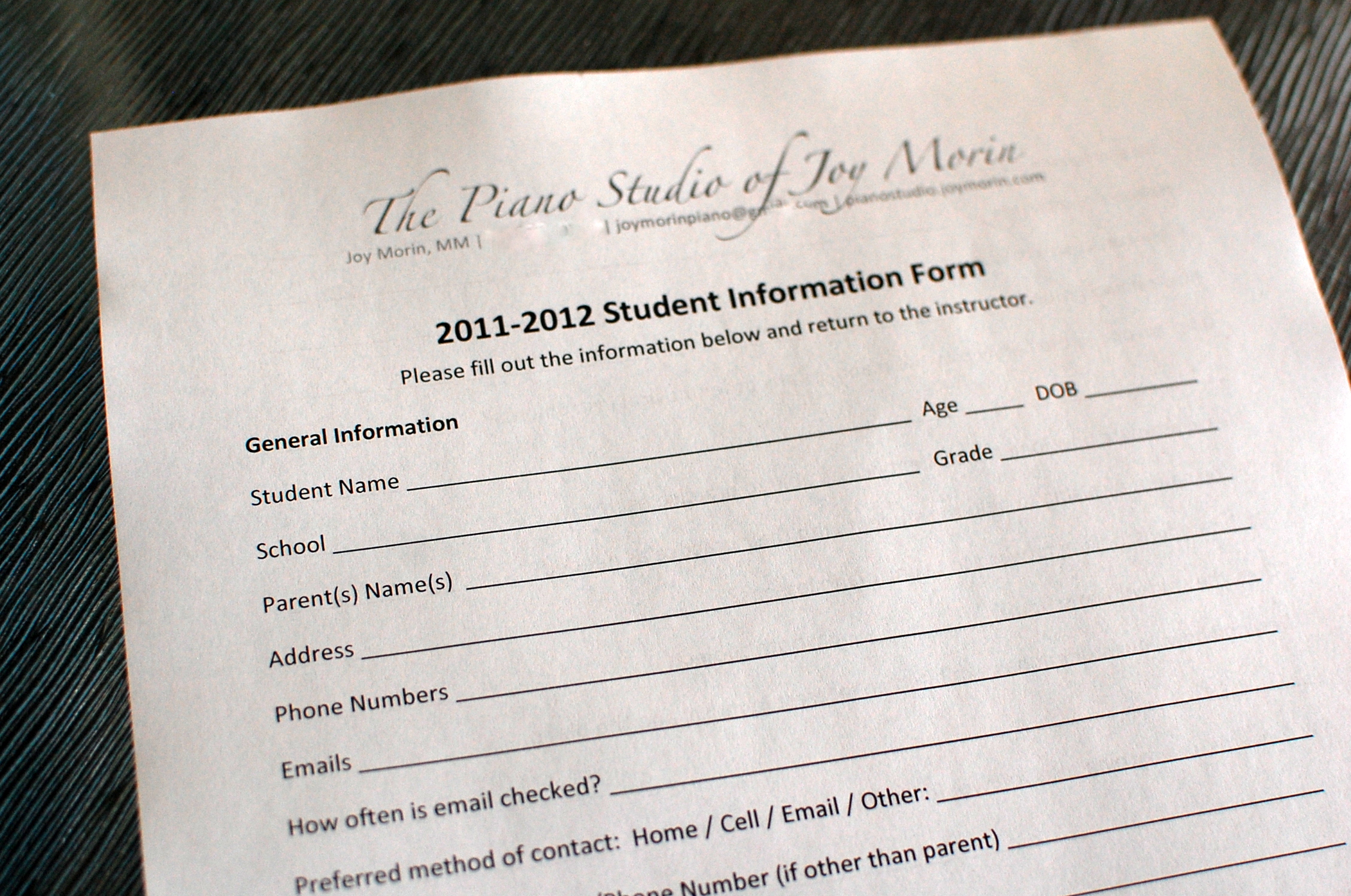 This Student Information Form is suitable for use at the interview / first lesson with a new or transfer student who you are accepting into your teaching studio. Adult students can fill this form out as a way of introduction, and parents can fill it out while the teacher is working with the student.
This Student Information Form is suitable for use at the interview / first lesson with a new or transfer student who you are accepting into your teaching studio. Adult students can fill this form out as a way of introduction, and parents can fill it out while the teacher is working with the student.
 2015 RCM Technical Requirements Charts for Piano
2015 RCM Technical Requirements Charts for Piano
» 557.9 KiB - 28,924 hits - 6 July 2015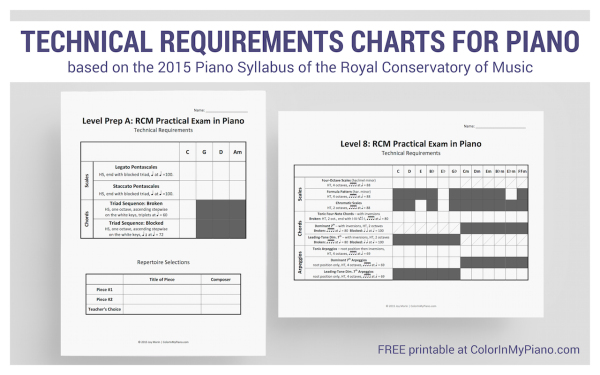 The Technical Requirements Charts within this PDF are designed to help piano students track their progress when preparing for the technique requirements of the Royal Conservatory of Music (RCM) assessments. Piano teachers with no intentions to send students for RCM assessments might also find the charts useful. Give students a print-out of the appropriate level and fill in each box of the chart with a checkmark or sticker as each requirement is mastered. Please understand that these charts CANNOT function as a replacement for the 2015 RCM Piano Syllabus – they are merely practice guides. Read more here.
The Technical Requirements Charts within this PDF are designed to help piano students track their progress when preparing for the technique requirements of the Royal Conservatory of Music (RCM) assessments. Piano teachers with no intentions to send students for RCM assessments might also find the charts useful. Give students a print-out of the appropriate level and fill in each box of the chart with a checkmark or sticker as each requirement is mastered. Please understand that these charts CANNOT function as a replacement for the 2015 RCM Piano Syllabus – they are merely practice guides. Read more here.
 2022 RCM Technical Requirements Charts for Piano
2022 RCM Technical Requirements Charts for Piano
» 1.2 MiB - 8,987 hits - 19 July 2022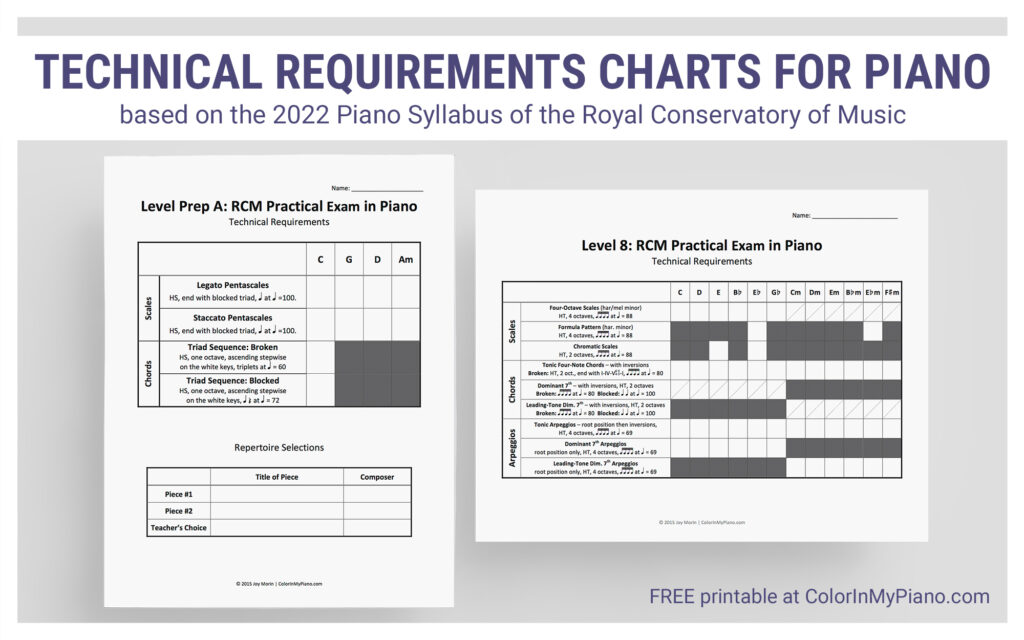 The Technical Requirements Charts within this PDF are designed to help piano students track their progress when preparing for the technique requirements of the Royal Conservatory of Music (RCM) assessments. Piano teachers with no intentions to send students for RCM assessments might also find the charts useful. Give students a print-out of the appropriate level and fill in each box of the chart with a checkmark or sticker as each requirement is mastered. Please understand that these charts CANNOT function as a replacement for the 2022 RCM Piano Syllabus – they are merely practice guides. Read more here.
The Technical Requirements Charts within this PDF are designed to help piano students track their progress when preparing for the technique requirements of the Royal Conservatory of Music (RCM) assessments. Piano teachers with no intentions to send students for RCM assessments might also find the charts useful. Give students a print-out of the appropriate level and fill in each box of the chart with a checkmark or sticker as each requirement is mastered. Please understand that these charts CANNOT function as a replacement for the 2022 RCM Piano Syllabus – they are merely practice guides. Read more here.
 5FPs & Scales - Patterns of Black & White Keys
5FPs & Scales - Patterns of Black & White Keys
» 54.4 KiB - 44,778 hits - 19 February 2013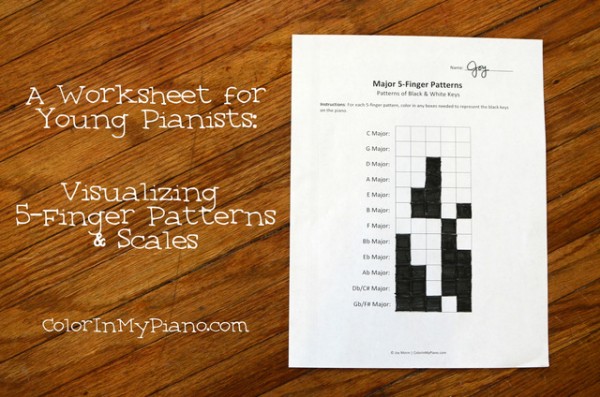 This set of worksheets is designed to help students as they learn to master their 5-finger patterns (aka pentascales) and scale. Each 5FP/scale has a series of boxes behind it, representing the notes of the 5FP/scale. The student's job is the fill in the boxes that would be black keys on the piano. The goal is for the student to visually memorize the pattern of black and white keys for each 5FP, and this worksheet will help with that. I've made five pages in this pdf: (1) Major 5FPs, in the order of the Circle of 5ths; (2) Major 5FPs, in the order of the scale (C up through B); (3) Minor 5FPs, in the order of the Circle of 5ths; (4) Major Scales; (5) Natural Minor Scales. Click here to read the original blog post about this worksheet.
This set of worksheets is designed to help students as they learn to master their 5-finger patterns (aka pentascales) and scale. Each 5FP/scale has a series of boxes behind it, representing the notes of the 5FP/scale. The student's job is the fill in the boxes that would be black keys on the piano. The goal is for the student to visually memorize the pattern of black and white keys for each 5FP, and this worksheet will help with that. I've made five pages in this pdf: (1) Major 5FPs, in the order of the Circle of 5ths; (2) Major 5FPs, in the order of the scale (C up through B); (3) Minor 5FPs, in the order of the Circle of 5ths; (4) Major Scales; (5) Natural Minor Scales. Click here to read the original blog post about this worksheet.
 About Me - Student Profile Cards
About Me - Student Profile Cards
» 118.8 KiB - 7,993 hits - 10 August 2017 At the beginning of the school year, print these out on colorful paper and take time during lessons to fill them out with students using a felt-tipped marker. Add a photos of each student and hang them in your studio using clothespins on a piece of twine string. Your students will love it! Read more details about the process here.
At the beginning of the school year, print these out on colorful paper and take time during lessons to fill them out with students using a felt-tipped marker. Add a photos of each student and hang them in your studio using clothespins on a piece of twine string. Your students will love it! Read more details about the process here.
 Analyzing & Composing in the Romantic Style - Lesson Plans & Worksheets
Analyzing & Composing in the Romantic Style - Lesson Plans & Worksheets
» 1.0 MiB - 35,528 hits - 1 November 2009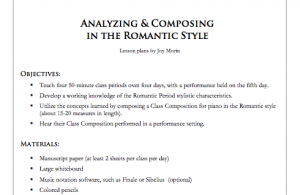 This lesson plan (four days + a performance) is designed to teach music students about Analyzing and Composing in the Romantic Style. Although originally created for a class sizes of 6-8 piano students ranging in age from 9-15, these plans may be easily adapted for other uses. Read more here.
This lesson plan (four days + a performance) is designed to teach music students about Analyzing and Composing in the Romantic Style. Although originally created for a class sizes of 6-8 piano students ranging in age from 9-15, these plans may be easily adapted for other uses. Read more here.
 Arr Jingle Bells
Arr Jingle Bells
» 40.1 KiB - 30,157 hits - 27 September 2009
This arrangement of Jingle Bells is for beginner piano students who are comfortable reading on the staff and playing in the key of C.
 Arr Joy To The World
Arr Joy To The World
» 36.5 KiB - 19,909 hits - 27 September 2009
This arrangement is suitable for beginner piano students who are comfortable reading on the staff notation and playing in the key of C.
 Arr O Come All Ye Faithful
Arr O Come All Ye Faithful
» 36.7 KiB - 14,694 hits - 27 September 2009
This arrangement is suitable for beginner piano students who are comfortable reading notes on the staff and playing in Middle C position.
 Arr We Wish You A Merry Christmas
Arr We Wish You A Merry Christmas
» 35.5 KiB - 16,539 hits - 23 September 2009
This arrangement of We Wish You A Merry Christmas is suitable for beginner students who are comfortable reading notes on the staff and playing in the Middle C position.
 BANG! Rhythm game
BANG! Rhythm game
» 1.1 MiB - 40,484 hits - 18 March 2014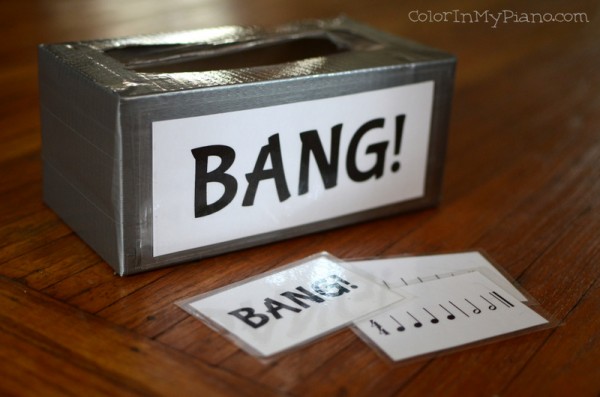 This pdf contains the BANG! cards and container labels for playing the BANG! Rhythm Game. Gameplay: Each student draws a card from the box on their turn. If they answer the card correctly, they get to the keep the card. If they draw a BANG! card, they must return all their cards to the box. The student with the most cards at the end is the winner. (Note: The rhythm cards pictured are available in my shop here. You can also substitute note-naming flashcards instead of rhythm cards.) To view the original blog post about this game, click here.
This pdf contains the BANG! cards and container labels for playing the BANG! Rhythm Game. Gameplay: Each student draws a card from the box on their turn. If they answer the card correctly, they get to the keep the card. If they draw a BANG! card, they must return all their cards to the box. The student with the most cards at the end is the winner. (Note: The rhythm cards pictured are available in my shop here. You can also substitute note-naming flashcards instead of rhythm cards.) To view the original blog post about this game, click here.
 BINGO Sheet for Piano Students
BINGO Sheet for Piano Students
» 59.5 KiB - 5,205 hits - 9 April 2020 This BINGO sheet is appropriate for piano students of all ages and levels. The activities on the sheet encourage students to engage creatively with their piano playing, often with the help of a friend or family member. Examples include: Surprise your teacher with a new piece you learned all by yourself, learn a tune by ear, and try changing the style of one of your pieces. Teachers can encourage students to get five-in-a-row or to complete the entire sheet! To read the original blog post about this printable, click here.
This BINGO sheet is appropriate for piano students of all ages and levels. The activities on the sheet encourage students to engage creatively with their piano playing, often with the help of a friend or family member. Examples include: Surprise your teacher with a new piece you learned all by yourself, learn a tune by ear, and try changing the style of one of your pieces. Teachers can encourage students to get five-in-a-row or to complete the entire sheet! To read the original blog post about this printable, click here.
 Black Key Group Sorting Cards
Black Key Group Sorting Cards
» 258.0 KiB - 56,136 hits - 20 November 2012 These cards are a great manipulative to use with young beginners when you are first introducing them to the keyboard. Students can use the cards to build a keyboard on the floor, alternating the groups of 2 and 3 black keys. Or, students can use these at the piano, and lay the cards right on the piano keyboard, matching the groups of black keys appropriately. I printed a few sets of these cards, laminated them, and put them in zipper bags. This short activity is great for Piano Readiness Classes. There are two versions included in the pdf: one with the letter names on the keys, and one without.
These cards are a great manipulative to use with young beginners when you are first introducing them to the keyboard. Students can use the cards to build a keyboard on the floor, alternating the groups of 2 and 3 black keys. Or, students can use these at the piano, and lay the cards right on the piano keyboard, matching the groups of black keys appropriately. I printed a few sets of these cards, laminated them, and put them in zipper bags. This short activity is great for Piano Readiness Classes. There are two versions included in the pdf: one with the letter names on the keys, and one without.
 Board Game: Adventures In Music
Board Game: Adventures In Music
» 764.2 KiB - 48,125 hits - 17 February 2010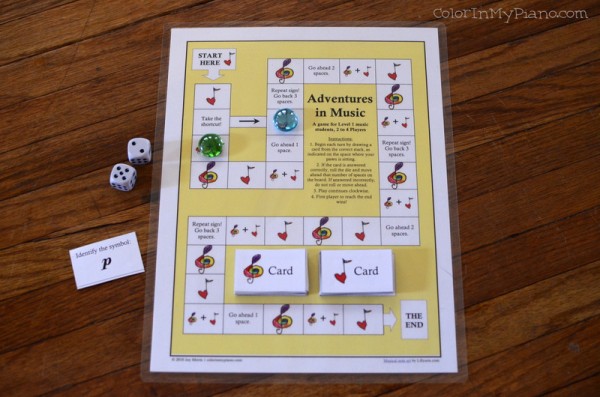 This piano-bench-sized board game is appropriate for elementary music students, such as piano students who are Level 1 or 2 of a piano method. This game works well for two players (teacher and student) during a private lesson, or during a group activity involved 3, 4, or maybe 5 students. Materials needed: 1 or 2 dice (depending on how fast you'd like the game to progress) and several pawns (colored glass baubles from the dollar store work well). To view the original blog post about this game, click here. (Special thanks to Lillyarts.com for giving me permission to use her music illustrations!)
This piano-bench-sized board game is appropriate for elementary music students, such as piano students who are Level 1 or 2 of a piano method. This game works well for two players (teacher and student) during a private lesson, or during a group activity involved 3, 4, or maybe 5 students. Materials needed: 1 or 2 dice (depending on how fast you'd like the game to progress) and several pawns (colored glass baubles from the dollar store work well). To view the original blog post about this game, click here. (Special thanks to Lillyarts.com for giving me permission to use her music illustrations!)
 Business Cards Template for Music Teachers
Business Cards Template for Music Teachers
» 48.0 KiB - 18,790 hits - 16 December 2009 This Microsoft Word (.doc) file contains a page of 10 business cards. Once you download the file, you can easily edit the document to fill in your name and contact information. Then all you have to do is print them onto white cardstock or other professional-looking paper and cut them apart. Business cards are important for any professional, including music teachers!
This Microsoft Word (.doc) file contains a page of 10 business cards. Once you download the file, you can easily edit the document to fill in your name and contact information. Then all you have to do is print them onto white cardstock or other professional-looking paper and cut them apart. Business cards are important for any professional, including music teachers!
 CD Lending Library Printables
CD Lending Library Printables
» 110.6 KiB - 5,563 hits - 13 November 2014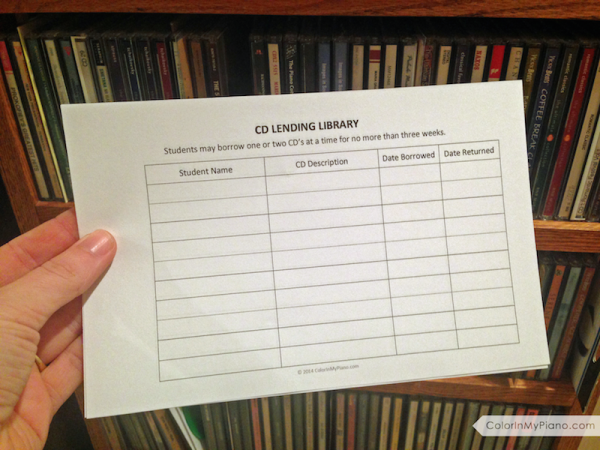 Why not dust off your CD's and create a lending library for your students to enjoy? This Microsoft Word document contains two things: (1) customizable dividers for organizing your CD library, and (2) a form that students fill out for loaning CD's from your lending library. Directions for customizing and printing the dividers can be found within the Word doc. Read the blog post about this idea here.
Why not dust off your CD's and create a lending library for your students to enjoy? This Microsoft Word document contains two things: (1) customizable dividers for organizing your CD library, and (2) a form that students fill out for loaning CD's from your lending library. Directions for customizing and printing the dividers can be found within the Word doc. Read the blog post about this idea here.
 Circling Fun Sheets
Circling Fun Sheets
» 38.6 KiB - 19,569 hits - 21 August 2015 This PDF contains a couple of circling sheets inspired by Irina Gorin (of the Tales of a Musical Journey piano method). When I attended Irina's three-day workshop in 2015, she mentioned a few (non-musical) activities that can help students improve their focus, concentration, and memory skills. One activity was to give students a page with random single-digit numbers all over it and ask them to circle all of the 2's (or whatever number you choose). I decided to make a music note version of this sheet because I thought it would be fun to for students to do while in the waiting room area of my studio. I printed it two-sided, laminated the sheet, and plan to pair it with a dry erase marker. To view the original blog post about this, click here.
This PDF contains a couple of circling sheets inspired by Irina Gorin (of the Tales of a Musical Journey piano method). When I attended Irina's three-day workshop in 2015, she mentioned a few (non-musical) activities that can help students improve their focus, concentration, and memory skills. One activity was to give students a page with random single-digit numbers all over it and ask them to circle all of the 2's (or whatever number you choose). I decided to make a music note version of this sheet because I thought it would be fun to for students to do while in the waiting room area of my studio. I printed it two-sided, laminated the sheet, and plan to pair it with a dry erase marker. To view the original blog post about this, click here.
 Composition/Improv Prompt - Free Sample
Composition/Improv Prompt - Free Sample
» 102.8 KiB - 17,096 hits - 21 October 2013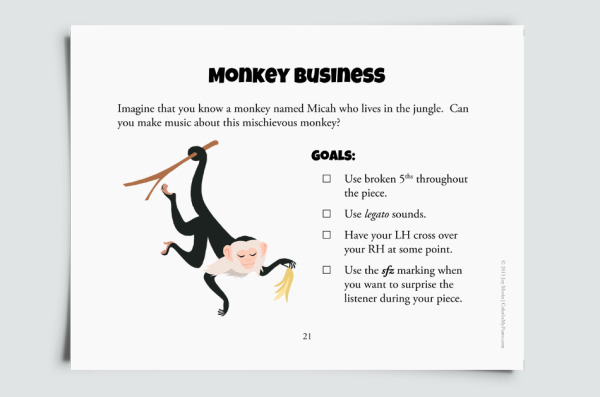 This one-page pdf is a FREE sample page taken from the "Prompts for Piano" e-book available in the Color In My Piano shop. "Prompts for Piano" is designed to provide an easy way for teachers to guide beginner and elementary students through composition or improvisation. I created the prompts to help my students get inspired during the initial stages of a composition assignment and to provide structure and guidance as they bring the piece to completion. You can read more about "Prompts for Piano" here in the Shop.
This one-page pdf is a FREE sample page taken from the "Prompts for Piano" e-book available in the Color In My Piano shop. "Prompts for Piano" is designed to provide an easy way for teachers to guide beginner and elementary students through composition or improvisation. I created the prompts to help my students get inspired during the initial stages of a composition assignment and to provide structure and guidance as they bring the piece to completion. You can read more about "Prompts for Piano" here in the Shop.
 Concepts to Introduce Using Improvisation
Concepts to Introduce Using Improvisation
» 53.5 KiB - 17,185 hits - 30 January 2010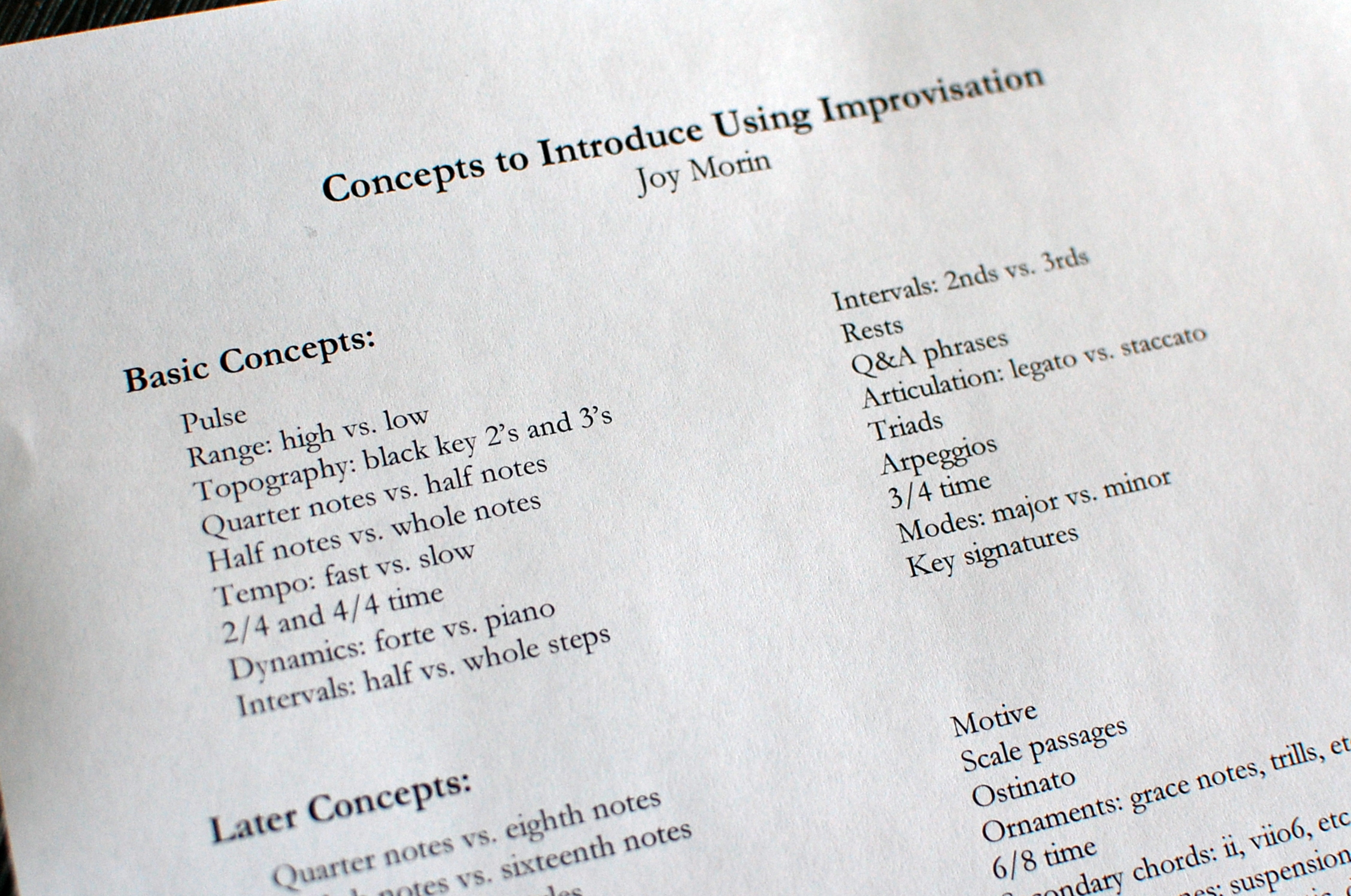 This pdf lists various musical concepts which can be taught through improvisation. Using concept-based improvisation is an efficient way to encourage improvisation with your students, while reinforcing the things they are learning in their piano method books. The list is divided into two sections: beginner concepts, and more advanced concepts.
This pdf lists various musical concepts which can be taught through improvisation. Using concept-based improvisation is an efficient way to encourage improvisation with your students, while reinforcing the things they are learning in their piano method books. The list is divided into two sections: beginner concepts, and more advanced concepts.
 DIY Silent Mini Keyboards
DIY Silent Mini Keyboards
» 751.2 KiB - 21,465 hits - 25 October 2010 This pdf contains do-it-yourself instructions for making your own set of 6 silent mini keyboards using wooden slats and black foam. Silent keyboards can be used in a variety of ways, ranging from pre-piano classes with young children to advanced theory classes with older students. Try using glass gems on the keyboards to form chords and 5-finger patterns. Be creative, and see what games and activities you come up with!
This pdf contains do-it-yourself instructions for making your own set of 6 silent mini keyboards using wooden slats and black foam. Silent keyboards can be used in a variety of ways, ranging from pre-piano classes with young children to advanced theory classes with older students. Try using glass gems on the keyboards to form chords and 5-finger patterns. Be creative, and see what games and activities you come up with!
 Errata Sheet for Hazel Cobb's Technique Builders - by Joy Morin
Errata Sheet for Hazel Cobb's Technique Builders - by Joy Morin
» 347.1 KiB - 448 hits - 27 January 2023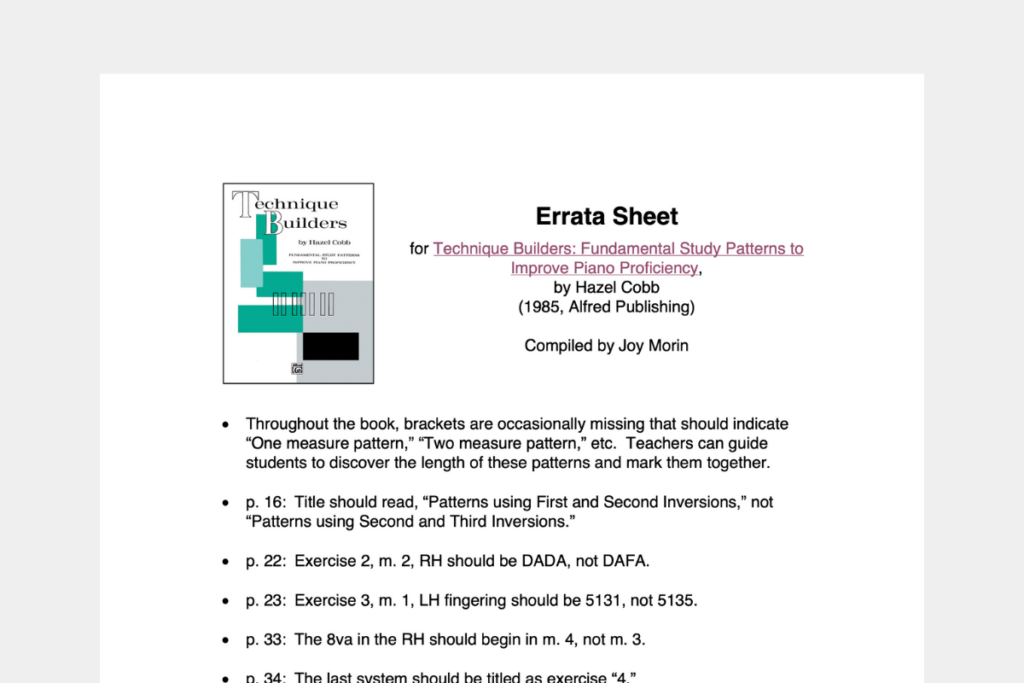 Hazel Cobb's Technique Builders book is a wonderful resource for intermediate piano students. The only caveat I have to recommending the book is the fact that there are a number of editorial mistakes in the book. Although it is inconvenient to have to correct these errors, it is not enough to deter me from using this book with my students. And I created this errata sheet to help make things easier. Read my full review of Hazel Cobb's Technique Builders book here.
Hazel Cobb's Technique Builders book is a wonderful resource for intermediate piano students. The only caveat I have to recommending the book is the fact that there are a number of editorial mistakes in the book. Although it is inconvenient to have to correct these errors, it is not enough to deter me from using this book with my students. And I created this errata sheet to help make things easier. Read my full review of Hazel Cobb's Technique Builders book here.
 Finger Number Beanbag Game
Finger Number Beanbag Game
» 177.7 KiB - 18,040 hits - 21 January 2013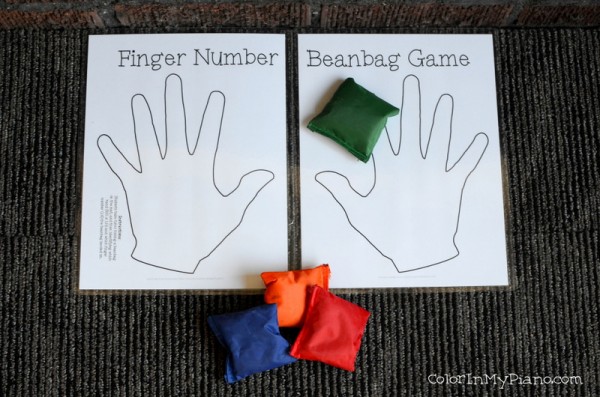 This quick, easy game is a great way to review the piano fingering and RH versus LH with young beginner piano students. Students stand in front of the mat and toss a beanbag, and then name the finger the beanbag landest closest to, and whether it is on the RH or LH. I laminated the pages and taped them together so that the mat folds for easy storage. The game idea is credited to Becki Lewis (view her blog here). To view the original blog post about this game, click here.
This quick, easy game is a great way to review the piano fingering and RH versus LH with young beginner piano students. Students stand in front of the mat and toss a beanbag, and then name the finger the beanbag landest closest to, and whether it is on the RH or LH. I laminated the pages and taped them together so that the mat folds for easy storage. The game idea is credited to Becki Lewis (view her blog here). To view the original blog post about this game, click here.
 Five-Finger Pattern Review (# and b keys)
Five-Finger Pattern Review (# and b keys)
» 248.6 KiB - 37,581 hits - 17 March 2012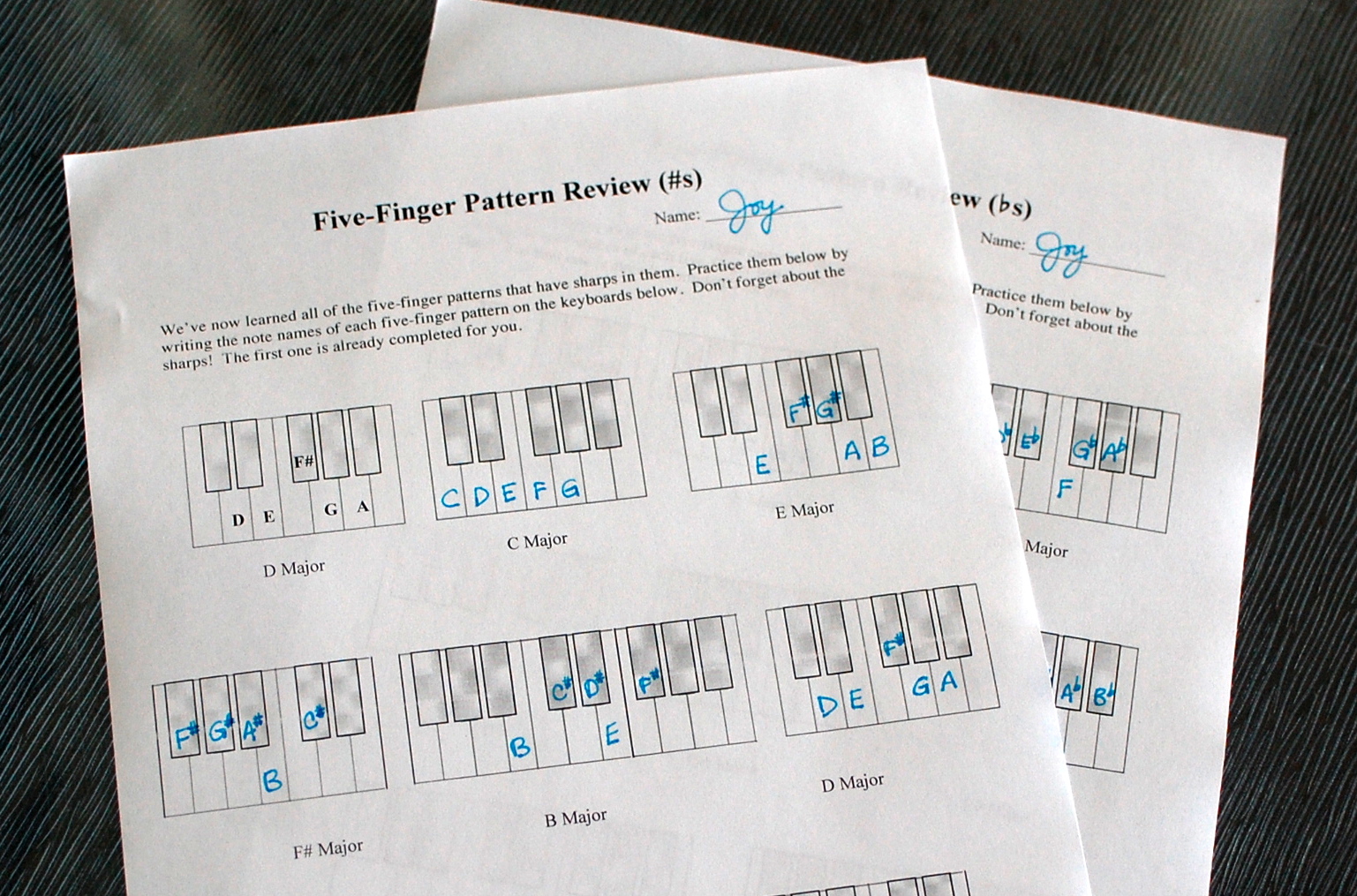 This pdf contains a pair of worksheets intended as a review of all the major five-finger patterns (5FPs); however, using the "WWHW" pattern template, students can easily figure out any 5FPs that they might not already be familiar with. This worksheet will help students become more familiar with the accidentals needed for each FFP and what each FFP looks like when played on the keyboard.
This pdf contains a pair of worksheets intended as a review of all the major five-finger patterns (5FPs); however, using the "WWHW" pattern template, students can easily figure out any 5FPs that they might not already be familiar with. This worksheet will help students become more familiar with the accidentals needed for each FFP and what each FFP looks like when played on the keyboard.
 Flashcards: Melodic Patterns 1 & 2
Flashcards: Melodic Patterns 1 & 2
» 117.9 KiB - 27,386 hits - 4 October 2009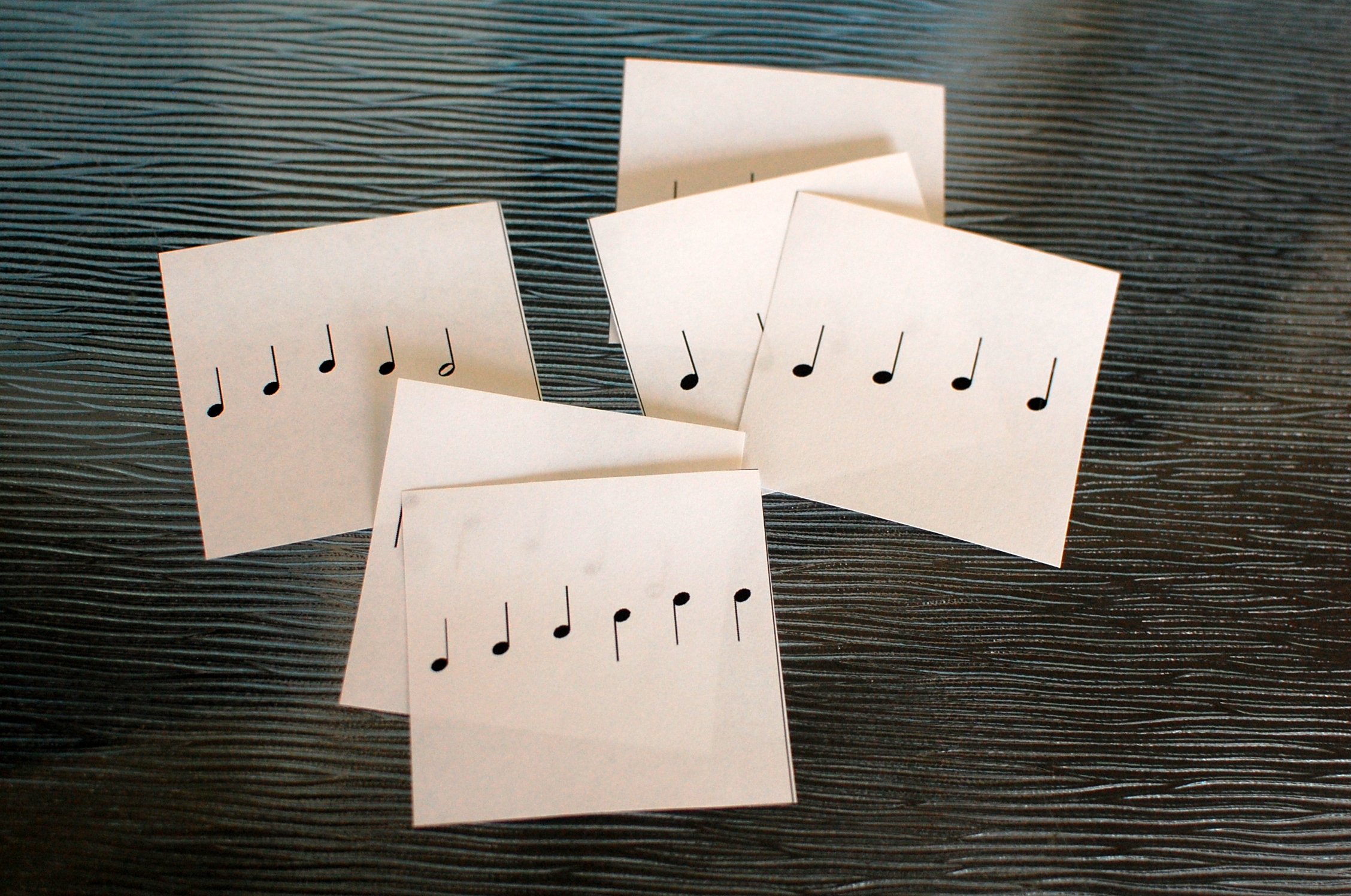 This pdf contains two pages of flashcards of off-staff notes. These flashcards have a variety of uses, mainly for beginner piano students. You could ask the student to: 1) clap the rhythm, 2) play the pattern on the piano, or 3) play the pattern on the piano and then transpose it to another key.
This pdf contains two pages of flashcards of off-staff notes. These flashcards have a variety of uses, mainly for beginner piano students. You could ask the student to: 1) clap the rhythm, 2) play the pattern on the piano, or 3) play the pattern on the piano and then transpose it to another key.
 Flashcards: Naming Notes (Middle C Position)
Flashcards: Naming Notes (Middle C Position)
» 45.6 KiB - 38,100 hits - 11 October 2009 Here is a set of flashcards for the beginner piano student who is learning about reading notes on the staff and playing in the Middle C position.
Here is a set of flashcards for the beginner piano student who is learning about reading notes on the staff and playing in the Middle C position.
 Gallery of Music - Symbol Drawing Worksheets
Gallery of Music - Symbol Drawing Worksheets
» 1.3 MiB - 62,974 hits - 14 February 2012 This is a set of simple worksheets for having students learn/draw various music symbols. The worksheets can be used singly or in groups, depending on what concepts your students are currently learning. I would encourage students to use colorful crayons to draw the symbols. Please refer to the corresponding blog post for more information.
Here are the symbols covered on each page:
1. Quarter, half, dotted-quarter, and whole notes.
2. Quarter, half, dotted-quarter, and whole rests.
3. Single eighth note, beamed eighth notes, eighth rest, and dotted quarter note.
4. Treble clef, bass clef, staff, and grand staff.
5. Barline, double barline, repeat sign, and time signature.
6. Forte, piano, mezzo forte, and mezzo piano.
7. Sharp, flat, natural, quarter note with flat.
8. Slur, tie, staccato, accent.
This is a set of simple worksheets for having students learn/draw various music symbols. The worksheets can be used singly or in groups, depending on what concepts your students are currently learning. I would encourage students to use colorful crayons to draw the symbols. Please refer to the corresponding blog post for more information.
Here are the symbols covered on each page:
1. Quarter, half, dotted-quarter, and whole notes.
2. Quarter, half, dotted-quarter, and whole rests.
3. Single eighth note, beamed eighth notes, eighth rest, and dotted quarter note.
4. Treble clef, bass clef, staff, and grand staff.
5. Barline, double barline, repeat sign, and time signature.
6. Forte, piano, mezzo forte, and mezzo piano.
7. Sharp, flat, natural, quarter note with flat.
8. Slur, tie, staccato, accent.
 Grand Staff Pass
Grand Staff Pass
» 2.6 MiB - 36,915 hits - 8 January 2013 "Grand Staff Pass" is a activity for finding and naming notes on the grand staff. Each student has a printed grand staff in front of them, and must find the notes as indicated on the cards. The cards are passed to the next student, going counterclockwise around the room. The complete instructions for this activity are included in the pdf. To read more about this game, please read the original blog post here.
"Grand Staff Pass" is a activity for finding and naming notes on the grand staff. Each student has a printed grand staff in front of them, and must find the notes as indicated on the cards. The cards are passed to the next student, going counterclockwise around the room. The complete instructions for this activity are included in the pdf. To read more about this game, please read the original blog post here.
 Grand Staff Reference Sheet - Naming Space Notes
Grand Staff Reference Sheet - Naming Space Notes
» 190.2 KiB - 2,632 hits - 24 January 2022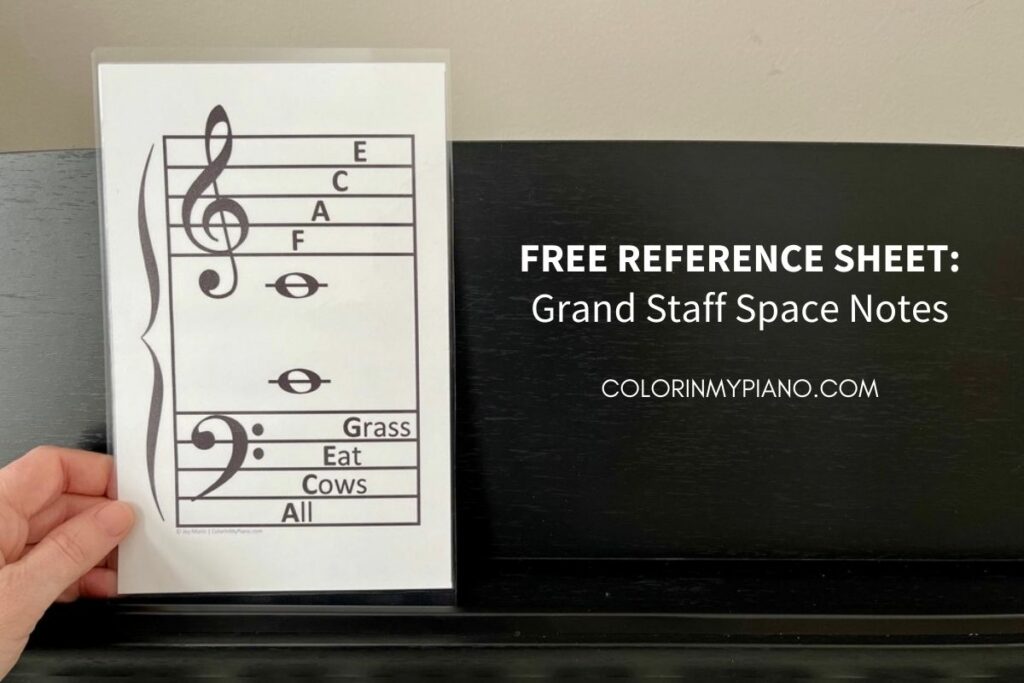 In most cases, I tend to avoid having students use mnemonic devices as a tool to identifying notes on the grand staff. If I DO use mnemonic devices with a student, we use them only lightly and we only use two: "FACE" for treble clef spaces and "All Cows Eat Grass" for bass clef spaces. This is enough for figuring out any note on the grand staff, and is far less confusing than trying to keep four different mnemonic devices straight (you know...for the treble clef lines, treble clef spaces, bass clef lines, and bass clef spaces). In all best case scenarios with mnemonic devices, we don't rely on them for long. Ideally, students quickly move on from this and become fluent in recognizing what they see in notation as something familiar for their ears and bodies at the piano! This reference sheet is a tool to help students correct any past misunderstandings about the grand staff and get on track towards a better music reading process.
Read further discussion on reading music and this printable here.
In most cases, I tend to avoid having students use mnemonic devices as a tool to identifying notes on the grand staff. If I DO use mnemonic devices with a student, we use them only lightly and we only use two: "FACE" for treble clef spaces and "All Cows Eat Grass" for bass clef spaces. This is enough for figuring out any note on the grand staff, and is far less confusing than trying to keep four different mnemonic devices straight (you know...for the treble clef lines, treble clef spaces, bass clef lines, and bass clef spaces). In all best case scenarios with mnemonic devices, we don't rely on them for long. Ideally, students quickly move on from this and become fluent in recognizing what they see in notation as something familiar for their ears and bodies at the piano! This reference sheet is a tool to help students correct any past misunderstandings about the grand staff and get on track towards a better music reading process.
Read further discussion on reading music and this printable here.
 Hands and Fingers at the Piano
Hands and Fingers at the Piano
» 55.8 KiB - 39,003 hits - 21 March 2010
In this worksheet, the student is instructed to trace their hands, and label the finger numbers on each finger. Objectives: The student recognizes the left hand versus the right hand;
the student learns the abbreviations "LH" and "RH"; and
the student understands the fingering numbering system for piano (1-5), for both hands.
 Happy Birthday Song
Happy Birthday Song
» 31.0 KiB - 19,065 hits - 14 April 2013
This pdf is a simple arrangement of the Happy Birthday song. Younger students can simply play the two-handed melody as written. Older students can play the entire melody in the RH and accompany with a LH accompaniment, reading the chord symbols provided above the staff. Or, two students can play a duet with one student playing the melody, and the other playing a two-handed chordal accompaniment. (Lyrics are not included in the pdf because they are currently under copyright. The tune is in the public domain.)
 Heartbeat Charts for Rhythm Dictation
Heartbeat Charts for Rhythm Dictation
» 297.1 KiB - 13,115 hits - 13 November 2014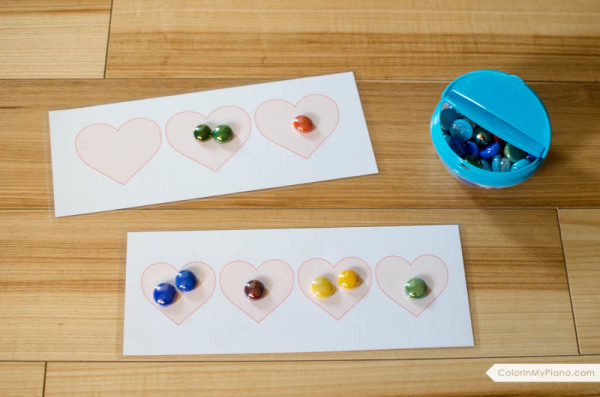 These Heartbeat Charts are perfect for making rhythm dictation easy and fun. Here is how the activity works: Each student is given a heartbeat chart and some game tokens. The teacher claps/chants a prepared rhythm and asks students to notate the rhythm on their heartbeat charts using game tokens. After a certain amount of time, the teacher describes or displays the correct answer and allows students to self-correct their work as necessary. Perfect for both one-on-one or group settings. It is easy to add a holiday theme to this activity. Read more here.
These Heartbeat Charts are perfect for making rhythm dictation easy and fun. Here is how the activity works: Each student is given a heartbeat chart and some game tokens. The teacher claps/chants a prepared rhythm and asks students to notate the rhythm on their heartbeat charts using game tokens. After a certain amount of time, the teacher describes or displays the correct answer and allows students to self-correct their work as necessary. Perfect for both one-on-one or group settings. It is easy to add a holiday theme to this activity. Read more here.
 History of Audio Formats - Lesson Plan
History of Audio Formats - Lesson Plan
» 6.7 MiB - 9,633 hits - 13 April 2015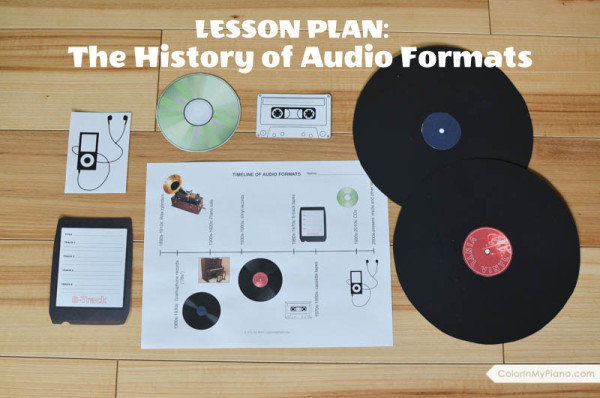 This PDF contains a lesson plan, timeline, craft activity, and slides for a group activity about the history of audio formats over the decades. The lesson begins with Thomas Edison's invention of the wax cylinder phonograph in 1877 and proceeds through mp3s, wavs, and other digital file formats of today. Learn more about this lesson plan by reading this blog post.
This PDF contains a lesson plan, timeline, craft activity, and slides for a group activity about the history of audio formats over the decades. The lesson begins with Thomas Edison's invention of the wax cylinder phonograph in 1877 and proceeds through mp3s, wavs, and other digital file formats of today. Learn more about this lesson plan by reading this blog post.
 Holiday Parade -- Mid Elementary Solo with Teacher Duet
Holiday Parade -- Mid Elementary Solo with Teacher Duet
» 2.2 MiB - 9,445 hits - 26 December 2014 This cheery Mid Elementary level piano solo includes a teacher duet. Joy composed this piece as a Christmas gift for her students, friends, and family in 2014. All rights are reserved on this composition, however, permission is granted for you to print/copy from the PDF for educational purposes. The PDF contains two versions of the music: 8.5''x11'' sized pages that will print well at home, and 12''x18'' pages that you could have printed at your local print shop (you could probably request them to print on 11''x17'' paper instead because it is more common and affordable in the U.S.). Click here to learn more about this project!
This cheery Mid Elementary level piano solo includes a teacher duet. Joy composed this piece as a Christmas gift for her students, friends, and family in 2014. All rights are reserved on this composition, however, permission is granted for you to print/copy from the PDF for educational purposes. The PDF contains two versions of the music: 8.5''x11'' sized pages that will print well at home, and 12''x18'' pages that you could have printed at your local print shop (you could probably request them to print on 11''x17'' paper instead because it is more common and affordable in the U.S.). Click here to learn more about this project!
 Ice Cream Interval game - SAMPLE
Ice Cream Interval game - SAMPLE
» 2.9 MiB - 20,151 hits - 6 May 2013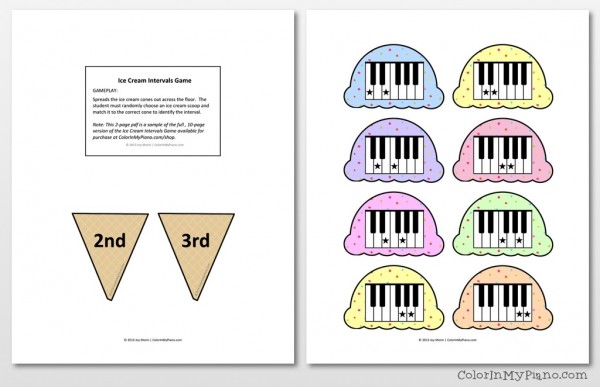 This free printable is a sample of the version available in the Color In My Piano shop for $8. The ice cream scoop cards in this sample are limited to 2nds and 3rds on the keyboard, which makes it perfect for preschoolers or other young beginners. Instructions for two games to play are included in the pdf. Read this post to learn more about the Ice Cream Interval game.
This free printable is a sample of the version available in the Color In My Piano shop for $8. The ice cream scoop cards in this sample are limited to 2nds and 3rds on the keyboard, which makes it perfect for preschoolers or other young beginners. Instructions for two games to play are included in the pdf. Read this post to learn more about the Ice Cream Interval game.
 Identifying Intervals worksheets
Identifying Intervals worksheets
» 39.0 KiB - 20,426 hits - 14 November 2013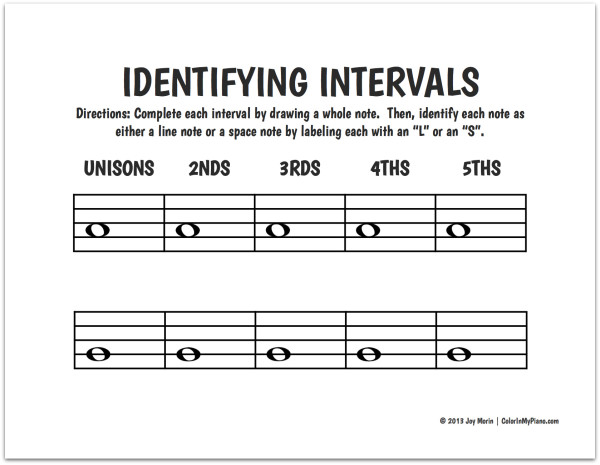 This series of interval worksheets are designed to help students learn to recognize intervals on sight, without "counting" between the notes. As students complete the worksheets, they should be encouraged to notice the line/space patterns that result with each interval. E.g., 3rds, and 5ths are similar in that they each result in a "line-to-line" (a line note going to another line note) or a "space-to-space." 2nds and 4ths are similar in that they each result in "line-to-space" or "space-to-line." Click here to read more and to learn about the digital version of this PDF (for use with the iPad and an annotation app such as GoodNotes).
This series of interval worksheets are designed to help students learn to recognize intervals on sight, without "counting" between the notes. As students complete the worksheets, they should be encouraged to notice the line/space patterns that result with each interval. E.g., 3rds, and 5ths are similar in that they each result in a "line-to-line" (a line note going to another line note) or a "space-to-space." 2nds and 4ths are similar in that they each result in "line-to-space" or "space-to-line." Click here to read more and to learn about the digital version of this PDF (for use with the iPad and an annotation app such as GoodNotes).

